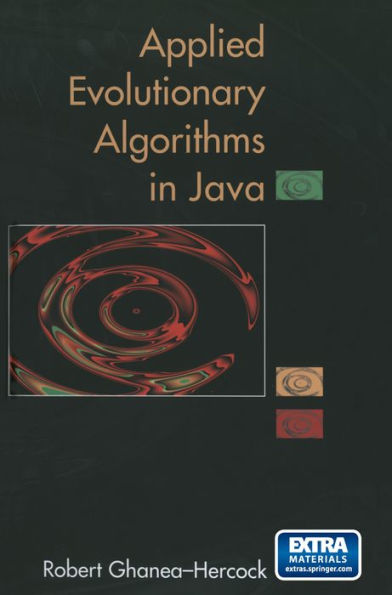5
1

Applied Evolutionary Algorithms in Java
by Robert Ghanea-Hercock
Robert Ghanea-Hercock

Applied Evolutionary Algorithms in Java
by Robert Ghanea-Hercock
Robert Ghanea-Hercock
eBook2003 (2003)
$41.49
$54.99
Save 25%
Current price is $41.49, Original price is $54.99. You Save 25%.
Available on Compatible NOOK devices, the free NOOK App and in My Digital Library.
WANT A NOOK?
Explore Now
Related collections and offers
41.49
In Stock
Overview
Genetic algorithms provide a powerful range of methods for solving complex engineering search and optimization algorithms. Their power can also lead to difficulty for new researchers and students who wish to apply such evolution-based methods. Applied Evolutionary Algorithms in JAVA offers a practical, hands-on guide to applying such algorithms to engineering and scientific problems. The concepts are illustrated through clear examples, ranging from simple to more complex problems domains; all based on real-world industrial problems. Examples are taken from image processing, fuzzy-logic control systems, mobile robots, and telecommunication network optimization problems. The JAVA-based toolkit provides an easy-to-use and essential visual interface, with integrated graphing and analysis tools. Topics and features: inclusion of a complete JAVA toolkit for exploring evolutionary algorithms; strong use of visualization techniques, to increase understanding; coverage of all major evolutionary algorithms in common usage; broad range of industrially based example applications; includes examples and an appendix based on fuzzy logic.

Product Details
| ISBN-13: | 9780387216157 |
|---|---|
| Publisher: | Springer-Verlag New York, LLC |
| Publication date: | 03/20/2013 |
| Sold by: | Barnes & Noble |
| Format: | eBook |
| File size: | 9 MB |
Table of Contents
1 Introduction to Evolutionary Computing.- 1.1 Evolutionary Computation.- 1.2 History of Evolutionary Computing.- 1.3 Obstacles to Evolutionary Computation.- 1.4 Machine Learning.- 1.5 Problem Domains.- 1.6 Applications.- 1.7 Evolution-Based Search.- 1.8 Summary.- Further Reading.- 2 Principles of Natural Evolution.- 2.1 Natural Selection.- 2.2 DNA Structure.- 2.3 Summary.- Further Reading.- 3 Genetic Algorithms.- 3.1 Genetic Algorithms.- 3.2 GA Basics.- 3.3 GA Theory.- 3.4 GA Operators.- 3.5 Pros and Cons of Genetic Algorithms.- 3.6 Selecting GA methods.- 3.7 Example GA Application.- 3.8 Summary.- Further Reading.- 4 Genetic Programming.- 4.1 Genetic Programming.- 4.2 Introduction to Genetic Programming.- 4.3 GP Operators.- 4.4 Genetic Programming Implementation.- 4.5 Summary.- Further Reading.- 5 Engineering Examples Using Genetic Algorithms.- 5.1 Introduction.- 5.2 Digital Image Processing.- 5.3 Basics of Image Processing.- 5.4 Java and Image Processing.- 5.5 Spectrographic Chromosome Representation.- 5.6 Results.- 5.7 Summary — Evolved Image Processing.- 5.8 Mobile Robot Control.- 5.9 Behaviour Management.- 5.10 Evolutionary Methods.- 5.11 Fuzzy logic Control.- 5.12 Evolved Fuzzy Systems.- 5.13 Robot Simulator.- 5.14 Analysis.- 5.15 Summary — Evolving Hybrid Systems.- Further Reading.- 6 Future Directions in Evolutionary Computing.- 6.1 Developments in Evolutionary Algorithms.- 6.2 Evolvable Hardware.- 6.3 Speciation and Distributed EA Methods.- 6.4 Advanced EA techniques.- 6.5 Artificial Life and Coevolutionary Algorithms.- 6.6 Summary.- Further Reading.- 7 The Future of Evolutionary Computing.- 7.1 Evolution in Action.- 7.2 Commercial value of Evolutionary Algorithms.- 7.3 Future Directions in Evolutionary Computing.- 7.4 Conclusion.- Appendix A.- A.1Java-based EA Software.- A.2 C/C++ based EA Software.- A.3 General Evolution and Robotics References.- A.4 Java Reference Guides.- A.5 Useful References.- Appendix B.- A Genetic Algorithm Example and the GPSYS GP Library.- B.1 Basic Genetic Algorithm.- B.2 Simple Java Genetic Algorithm.- Exercises.- B.2.1 Vectors and Arraylists.- B.3 Application Design.- B.4 Eos: An Evolutionary and Ecosystem Research Platform.- Authors: Erwin Bonsma, Mark Shackleton and Rob Shipman.- B.4.1 Introduction.- B.4.2 Design Overview.- B.4.3 Key Classes.- B.4.4 Configuration.- B.4.5 Illustrative Example Systems.- B.4.6 Aerial Placement for Mobile Networks.- B.4.7 An Ecosystem Simulation Based on Echo.- B.4.8 Coevolutionary Function Optimisation.- B.4.9 Telecommunications Research using Eos.- B.4.10 NetGrow: A Telecommunications Application.- B.4.11 Eos Summary.- B.5 Traveling Salesman Problem.- B.5.1 EOS Traveling Salesman Problem.- B.6 Genetic Programming.- B.6.1 Observations from Running GPsys — Lawnmower Problem.- Eos References.- Appendix C.- C.1 Fuzzy Logic.- C.2 Fuzzy Set Theory.- C.2.1 Fuzzy Operators.- C.2.2 Linguistic Variables.- C.2.3 Fuzzy IF.- C.2.4 Fuzzy Associative Memories.- C.2.5 Fuzzy Control Systems.- C.2.6 Defuzzification.- C.2.7 Fuzzy Applications.- C.3 Limitations of Fuzzy Control.- C.3.1 Advantages of Fuzzy Systems.- C.4 Summary.- Further Reading.- Appendix D.- System Overview.- Use and License.- Programming Language and Run-Time Environment.- Top-Level Directory Files and Hierarchy.- Units of Measure.- The Client-Server Architecture.- Network/Local Connections Versus Dynamically Loaded Clients.- Why a Client-Server Architecture?.- Client-Server Communications.- Network and Local Connection Issues.- Communication via Events and Requests.- Keeping the RPI ProtocolLanguage-Independent.- Configuration Elements and Properties Files.- The “port” and “hostName” Properties.- Overriding Properties.- Loading RsProperties Files as a Resource.- The Server.- Server Properties Files.- Accepting Clients.- The Scheduler.- The Floor Plan.- Syntax and Semantics.- Building a Virtual Robot.- Thinking About Client Design.- The Demonstration Clients.- Life Cycle of the Demonstration Clients.- How ClnMain Extends RsClient and Implements RsRunnable.- The RsRunnable Interface.- Building RsRunnable and RsClient into ClnMain.- DemoMain Implements RsRunnable, But Does Not Extend RsClient.- The Execution of ClnMain.- Uploading the Body Plan.- Registering Event Handlers.- Running the Event Loop.- How the Demo Clients Work.- Physical Layout of ClientZero.- The RsBody and RsBodyPart Classes.- RsBodyShape.- RsWheelSystem.- The Sensor Classes.- RsBodyTargetSensor.- RsBodyContactSensor.- Events and Requests.From the B&N Reads Blog
Page 1 of
